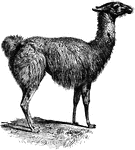Clipart tagged: ‘guanaco’

Guanaco
The guanaco (Lama guanicoe) is a camelid animal native to South America that stands between 107 and…

Guanaco
The Guanaco (Lama guanicoe) is a mammal in the Camelidae family of even-toed ungulates. It is a South…

Puma
The puma, also known as the cougar, panther, or mountain lion (Felis concolor) , is a large American…